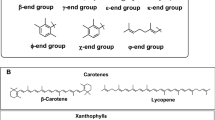Summary
-
1.
The pH dependence ofOctopus dofleini hemocyanin oxygenation is so great that below pH 7.0 the molecule does not become fully oxygenated, even in pure O2 at 1 atm pressure. However, the curves describing percent oxygenation as a function of\(P_{O_2 } \) appear to be gradually increasing in oxygen saturation, rather than leveling out at less than full saturation. Hill plots indicate that at pH 6.6 and below the molecule is stabilized in its low affinity conformation. Thus, the low saturation of this hemocyanin in air is due to the very large Bohr shift, and not to the disabling of one or more functionally distinct O2 binding sites on the native molecule.
-
2.
Experiments in which pH was monitored continuously while oxygenation was manipulated in the presence of CO2 provide no evidence of O2 linked binding of CO2. While CO2 does influence O2 affinity independently of pH, its effect may be due to high levels of HCO −3 and CO −3 , rather than molecular CO2, and it may entail a lowering of the activities of the allosteric effectors Mg2+ and Ca2+.
Similar content being viewed by others
References
Antonini E, Schuster TM, Brunori M, Wyman J (1965) The kinetics of the Bohr effect in the reaction of human hemoglobin with carbon monoxide. J Biol Chem 240:2262–2264
Dejours P (1981) Principles of comparative respiratory physiology. Elsevier/North Holland, Amsterdam
Horne RA (1964) Marine chemistry. Wiley-Interscience, New York
Houlihan DF, Innes AJ, Wells MJ, Wells J (1982) Oxygen consumption and blood gases ofOctopus vulgaris in hypoxic conditions. J Comp Physiol 148:35–40
Kuiper HA, Brunori M, Antonini E (1978) Kinetics of the Bohr effect in the reaction ofHelix pomatia β-hemocyanin with oxygen. Biochem Biophys Res Comm 82:1062–1069
Kuiper HA, Coletta M, Zolla L, Chiancone E, Brunori M (1980) Root effect ofPanulirus interruptus hemocyanin. Biochim Biophys Acta 626:412–416
Lenfant C, Johansen K (1965) Gas transport by hemocyanin-containing blood of the cephalopodOctopus dofleini. Am J Physiol 209:991–998
Lykkeboe G, Brix O, Johansen K (1980) Oxygen-linked CO2 binding independent of pH in cephalopod blood. Nature 287:330–331
Mangum CP, Burnett LE Jr (1986) The CO2 sensitivity of the hemocyanins and its relationship to Cl− sensitivity. Biol Bull 171:248–263
Mangum CP, Lykkeboe G (1979) The influence of inorganic ions and pH on oxygenation properties of the blood in the gastropod molluscBusycon canaliculatum. J Exp Zool 207:417–430
Miller KI (1985) Oxygen equilibria ofOctopus dofleini hemocyanin. Biochemistry 24:4582–4586
Miller KI, van Holde KE (1974) Oxygen binding byCallianassis californiensis hemocyanin. Biochemistry 13:1668–1674
Parsons TR, Parsons W (1923) Observations on the transport of carbon dioxide in the blood of some marine invertebrates. J Gen Physiol 6:153–166
Perutz MF (1983) Species adaptation in a protein molecule. Mol Biol Evol 1:1–28
Redfield AC, Goodkind R (1929) The significance of the Bohr effect in the respiration and asphyxiation of the squid,Loligo pealei. Br J Exptl Biol 6:340–349
Redfield AC, Coolidge T, Hurd AL (1926) The transport of oxygen and carbon dioxide by some bloods containing hemocyanin. J Biol Chem 69:475–509
Root RW (1931) The respiratory function of the blood of marine fishes. Biol Bull 61:427–455
Root RW, Irving L (1941) The equilibrium between hemoglobin and oxygen in whole and hemolyzed blood of the tautog, with a theory of the Haldane effect. Biol Bull 81:307–323
Wolvekamp HP (1938) Über den Sauerstofftransport durch Hämocyanin vonOctopus vulgaris Lam. undSepia officinalis L. Z Vergl Physiol 25:541–547
Author information
Authors and Affiliations
Rights and permissions
About this article
Cite this article
Miller, K.I., Mangum, C.P. An investigation of the nature of Bohr, Root, and haldane effects inOctopus dofleini hemocyanin. J Comp Physiol B 158, 547–552 (1988). https://doi.org/10.1007/BF00692562
Accepted:
Issue Date:
DOI: https://doi.org/10.1007/BF00692562




